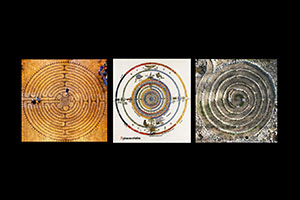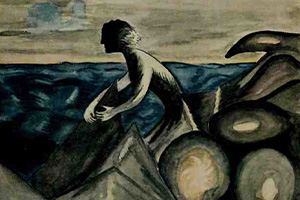The soul, too, according to tradition, has a round form. As the Monk of Heisterbach says, it is not only “like to the sphere of the moon, but is furnished on all sides with eyes” (ex omni parte oculata).. His remark refers in all probability to certain parapsychological phenomena, the “globes of light” or globular luminosities which, with remarkable consistency, are regarded as “souls” in the remotest parts of the world.
Archetypes of the Collective Unconscious
Paragraph 532
A Study in the Process of Individuation
Drawing 2 of Miss X

Again there are boulders, the round and pointed forms; but the round ones are no longer eggs, they are complete circles, and the pointed ones are tipped with golden light. One of the round forms has been blasted out of its place by a golden flash of lightning. The magician and magic wand are no longer there. The personal relationship to me seems to have ceased: the picture shows an impersonal natural process.
While Miss X was painting this picture she made all sorts of discoveries. Above all, she had no notion of what picture she was going to paint. She tried to reimagine the initial situation; the rocky shore and the sea are proof of this. But the eggs turned into abstract spheres or circles, and the magician’s touch be came a flash of lightning cutting through her unconscious state.
With this transformation she had rediscovered the historical synonym of the philosophical egg, namely the rotundum, the round. original form of the Anthropos (or ’round element,’ as Zosimos calls it). This is an idea that has been associated with the Anthropos since ancient times.
The soul, too, according to tradition, has a round form. As the Monk of Heisterbach says, it is not only “like to the sphere of the moon, but is furnished on all sides with eyes” (ex omni parte oculata). We shall come back to this motif of polyophthalmia later on. His remark refers in all probability to certain para psychological phenomena, the “globes of light” or globular luminosities which, with remarkable consistency, are regarded as “souls” in the remotest parts of the world.
The liberating flash of lightning is a symbol also used by Paracelsus and the alchemists for the same thing. Moses’ rock splitting staff, which struck forth the living, water and after wards changed into a serpent, may have been an unconscious echo in the background.
Lightning signifies a sudden, unexpected, and overpowering change of psychic condition… The flash is the “Birth of the light.” It has transformative power…
I will not attempt here any interpretation of Bohme’s symbols, but will only point out that in our picture the lightning, striking into the darkness and “hardness,” has blasted a ro undum out of the dark massa confusa and kindled a light in it.
There can be no doubt that the dark stone means the blackness, i.e., the unconscious, just as the sea and sky and the upper half of the woman’s figure indicate the sphere of consciousness. We may safely assume that Bohme’s symbol refers to a similar situation. The lightning has released the spherical form from the rock and so caused a kind of liberation. But, just as the magician has been replaced by the lightning, so the patient has been re placed by the sphere.
The unconscious has thus presented her with ideas which show that she had gone on thinking without the aid of consciousness and that this radically altered the initial situation. It was again her inability to draw that led to this result. Before finding this solution, she had made two attempts to portray the act of liberation with human figures, but with no success. She had overlooked the fact that the initial situation, her imprisonment in the rock, was already irrational and symbolic and therefore could not be solved in a rational ·way. It had to be done by an equally irrational process. That was why I advised her, should she fail in her attempt to draw human figures, to use some kind of hieroglyph. It then suddenly struck her that the sphere was a suitable symbol for the individual human being.
The form the picture had taken was not unreservedly welcome to the patient’s conscious mind. Luckily, however, while painting it Miss X had discovered that two factors were in volved. These, in her own words, were reason and the eyes. Reason always wanted to make the picture as it thought it ought to be; but the eyes held fast to their vision and finally forced the picture to come out as it actually did and not in accordance with rationalistic expectations. Her reason, she said, had really intended a daylight scene, with the sunshine melting the sphere free, but the eyes favoured a nocturne ·with “shattering, dangerous lightning.” This realization helped her to acknowledge the actual result of her artistic efforts and to admit that it was in fact an objective and impersonal process and not a personal relationship.
The patient’s association to lightning was that it might stand for intuition, a conjecture that is not far off the mark, since intuitions often come “like a flash.” Moreover, there are good grounds for thinking that Miss X was a sensation type. She her self thought she was one. The “inferior” function would then be intuition. As such, it would have the significance of a releasing or “redeeming” function. We know from experience that the inferior function always compensates, complements, and enhances the “superior” function. My psychic peculiarity would make me a suitable projection carrier in this respect. The inferior function is the one of which least conscious use is made. This is the reason for its undifferentiated quality, but also for its freshness and vitality. It is not at the disposal of the conscious mind, and even after long use it never loses its autonomy and spontaneity, or only to a very limited degree. Its role is therefore mostly that of a deus ex machina.
It depends not on the ego but on the self. Hence it hits consciousness unexpectedly, like lightning, and occasionally with devastating consequences. It thrusts the ego aside and makes room for a supraordinate factor, the totality of a person, which consists of conscious and unconscious and consequently extends far beyond the ego. This self was always present but sleeping, like Nietzsche’s “image in the stone.” It is, in fact, the secret of the stone, of the lapis philosohorum, in so far as this is the prima materia In the stone sleeps the spirit A!crcurius, the “circle of the moon,” the “round and square,” the homunculus, Tom Thumb and Anthropos at once, whom the alchemists also symbolized as their famed lapis philosophorum.
All these ideas and inferences were naturally unknown to my patient, and they were known to me at the time only in so far as I was able to recognize the circle as a mandala, the psychological expression of the totality of the self. Under these circumstances there could be no question of my having unintentionally infected her with alchemical ideas. The pictures are, in all essentials, genuine creations of the unconscious; their inessential aspects (landscape motifs) are derived from conscious contents.
Although the sphere with its glowing red centre and the golden flash of lightning play the chief part, it should not be overlooked that there are several other eggs or spheres as well. If the sphere signifies the self of the patient, we must apply this interpretation to the other spheres, too. They must therefore represent other people who, in all probability, were her inti mates. In both the pictures two other spheres are clearly indicated. So I must mention that Miss X had two women friends who shared her intellectual interests and were joined to her in a lifelong friendship. All three of them, as if bound together by fate, are rooted in the same “earth,” i.e., in the collective unconscious, which is one and the same for all. It is probably for this reason that the second picture has the decidedly nocturnal character intended by the unconscious and asserted against the wishes of the conscious mind. It should also be mentioned that the pointed pyramids of the first picture reappear in the second, where their points are actually gilded by the lightning and strongly emphasized. I would interpret them as unconscious contents “pushing up” into the light of consciousness, as seems to be the case with many contents of the collective unconscious. In contrast to the first picture, the second is painted in more vivid colours, red and gold. Gold expresses sunlight, value, divinity even. It is therefore a favourite synonym for the laj1is, being the aurum philosophicum or aurum potabile or aurum vitreum.
As already pointed out, I was not at that time in a position to reveal anything of these ideas to Miss X, for the simple reason that I myself knew nothing of them. I feel compelled to mention this circumstance yet again, because the third picture, which now follows, brings a motif that points unmistakably to alchemy and actually gave me the definitive incentive to make a thorough study of the works of the old adepts.
Archetypes of the Collective Unconscious
A Study in the Process of Indiduation
Paragraphs 531-544




One Comment